Advocates have been pushing for a change in how crash data is collected. If you spend time in Connecticut’s database, you’ll be both impressed by how much information is provided for every collision, and simultaneously annoyed by what is left out. For instance, after a fatal pedestrian collision, reporters often parrot the police in saying something like “the pedestrian was not in the crosswalk,” but they do not acknowledge that the nearest marked crosswalk was a mile away and inaccessible due to lack of sidewalks. The crash database might reflect reality conditions in the crash diagram — if one is provided — but there is no space, currently, for information about what infrastructure was present for pedestrians. Those reporting with more integrity don’t ding the pedestrian for wrongdoing, but others will say person was using roadway improperly. You can see how this feels like a set up, and how otherwise logical people begin to believe the myth that pedestrians come out of nowhere. It is rare for motorists who are paying attention to encounter a true surprise pedestrian scenario.
Those who are serious about making a dramatic reduction in serious and fatal collisions don’t spend their time defending the broken status quo because of the rare exceptions.
My recent column for CT News Junkie is about how how red herrings (or lies, if we want to be more direct) threaten progress in reducing traffic violence. But it could have also been this, a reminder that there is something morally bankrupt about protecting motorists’ wallets rather than their lives, and the lives of anyone or anything they may snuff out due to fast and reckless driving.
Behind the scenes, some who could have but did not participate in the Vision Zero committee that shaped HB 5917 have relied on hypothetical scenarios while ignoring a well-documented actual equity issue: Black and Hispanic Americans are disproportionately the victims of traffic violence, and this is true whether inside or outside of a vehicle.
We know how to reduce street deaths. It’s no mystery. Changing the infrastructure takes awhile, but is the most effective method. While waiting for cities to add sidewalks, remove car lanes, and install protected bike lanes, automated enforcement should be used, widely.
Last weekend in Connecticut, seven people — this time all drivers or passengers in vehicles — died in crashes. Ever so predictably, the response has been some combination of sending “thoughts and prayers,” telling the public to “hug their loved ones tighter,” and begging/cajoling motorists to drive better.
Here’s the thing:

Asking motorists to drive better is not a strategy. There is no data showing that this method has proven results. It’s what we have leaned heavily on for the last century, yet here we are, every day seeing a steady stream of people killed in preventable collisions. Spend any time on or adjacent to roadways, paying attention, and you will see the driver behavior does not even visibly improve in areas where there was a recent fatal crash.
Think about the advice given to those in parenting roles. Often, you have to make tough or unpopular decisions for the safety of the child. You tell them no, they can’t go to Cindy’s house for a party while her parents are out of town because you know this won’t be a quiet pajama party but the kind of rager where people pass out on the lawn. Junior is pissed, but Junior’s own track record of decisionmaking shows this is the right decision, and Junior won’t be waking up in the hospital getting fluids.
Automated enforcement may hurt people’s bank accounts.
Be mad about it.
It’s not getting pulled over by an officer who might escalate the situation. It’s not a speed trap where police station themselves to be not immediately noticed. (In my hometown, police would position themselves in a residential driveway at the bottom of a steep hill to catch people. Maybe they still do. This road is not where there are serious crashes — that would be the state routes, including where a head-on just killed two drivers recently.) There would be signs announcing the presence of cameras, and they would be used at intersections that have a history of serious crashes.
The opposition is telling on themselves and their own lawless driving, frankly.
With any luck, Connecticut’s decisionmakers have learned from their own peers that people make many poor choices behind the wheel, and that sometimes a bit of inconvenience is what will be best for them — and us all — in the long run.
———————-
In April, drivers killed five pedestrians on Connecticut’s roads.
The driver of an unknown make and model vehicle — this means the motorist did not remain on the scene — hit and killed a 30-year old woman from West Haven in that town on April 29 2023. Although she was described as being in the roadway improperly, you have to understand that she was set up for failure. There is no way for a pedestrian to properly use the road.
Route 162 in West Haven is a classic stroad. To cross it, a person would have to play frogger on five lanes with no median. There are many stores, along with bus stops, that would compel a person to use this area on foot.
There is no marked crosswalk or pedestrian light at the nearest intersection, and even if there were, there is no sidewalk or even much of a shoulder to walk in. The closest one is 0.1 miles away — a two minute walk — but there are no sidewalks on that side of Route 162.
Let’s look at this more carefully, because I don’t expect anyone else to unless a local lawyer decides that a class action suit is the way to go.
The map screenshot below (from October 2022) shows what Route 162 looks like near the intersection the pedestrian would have been expected to use. You can see that there is no sidewalk on one side of the stroad, and that there is not really any place to safely walk. The vegetation is overgrown and there is a fence that would keep people from walking at a safer distance from fast moving vehicles.
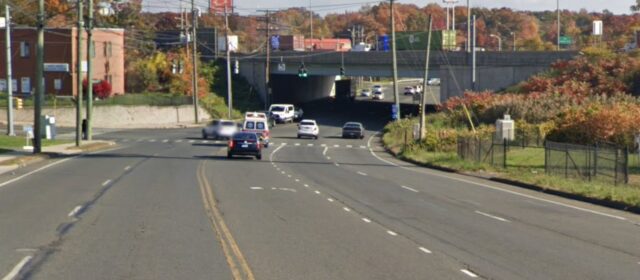
Let’s look more closely, still.
If someone managed to walk through the overgrown grass and shrubs — at night when they would not be able to see what was underfoot — they would reach a sidewalk-to-nowhere. These are little pourings of concrete that connect to nothing and are basically engineers saying out loud that they checked a box but don’t actually care about user experience.
You can see what looks like a beg button attached to this light, but there is more overgrown vegetation surrounding it.
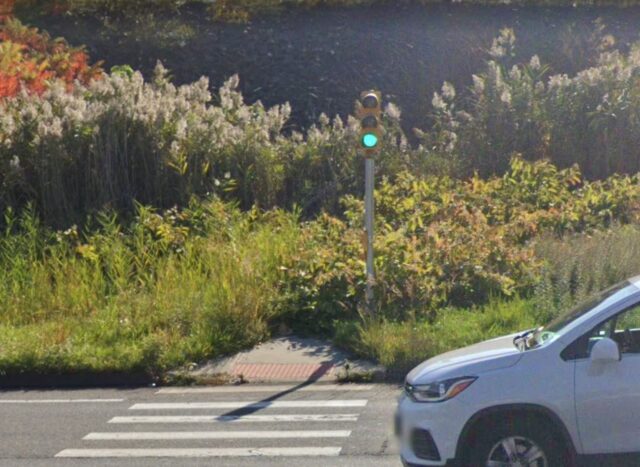
Let’s look even closer.
The screenshot below shows the other side of the intersection. There, you can see that the pedestrian would never be summoning their own light phase, but a green light. This is not pedestrian infrastructure. In a state where the gross norm is for motorists to turn right on red without pausing, nevermind to stop for those in the crosswalk, this faux beg button offers nothing.
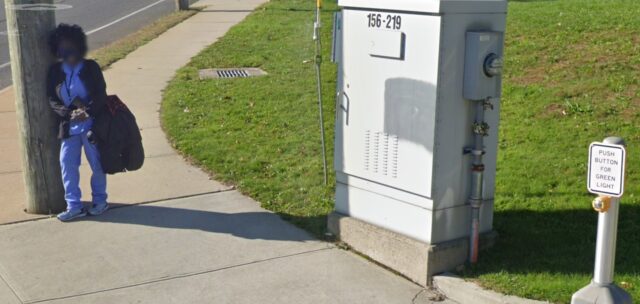
So, where the currently pedestrian was hit and killed is where most people would attempt to cross — from a stripmall driveway where there is at least some room to stand, across from a bus stop and apartment buildings. This happened at 12:30 AM, and while no information was provided as to where the victim was going, there is bus service in this area late at night. The CT Crash Data Repository describes this area as dark, not lighted.
Let’s look at all of the ways that West Haven and the State of Connecticut have been negligent: no crosswalk, no pedestrian light, no median, no sidewalk, no lighting, 35 MPH speed limit in a populated area. Add to this how the nearest intersection is a three-lane exit ramp that allows drivers to turn right on red. That’s seven bad choices that those in positions of power have repeatedly made, setting up both drivers and pedestrians for failure and danger.
I’ll add one more, actually.
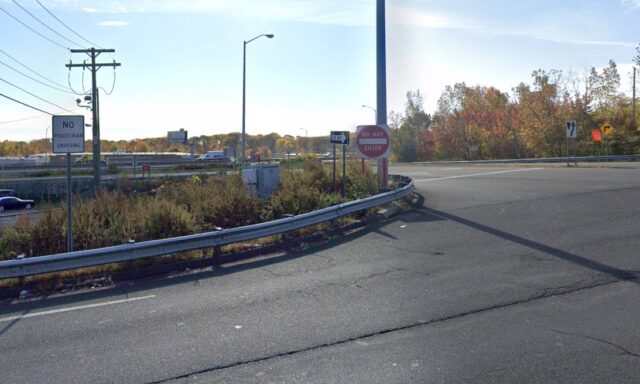
Instead of improving walkability, someone thought that installing a “NO PEDESTRIAN CROSSING” sign (that probably can’t be read from across the street) would be the way to go.
This is the crawliest way for the government, whether town or state, to admit that they are not interested in keeping people safe.
West Hartford recently did their own version of this, but with a “don’t you dare be poor in public” twist.
Asking pedestrians not to use an actual highway makes sense, but the second you start putting apartment buildings and retail plazas down, you need to accommodate those who are going to be living and working in those places — many of whom are taking the bus, biking, or relying on their own feet for transportation.
On April 7, 2023 around 4:09 PM, the driver of a 2015 Kia struck and killed Edward Patrick Austin, 49, of and in Milford.
Here’s what the area looks like:
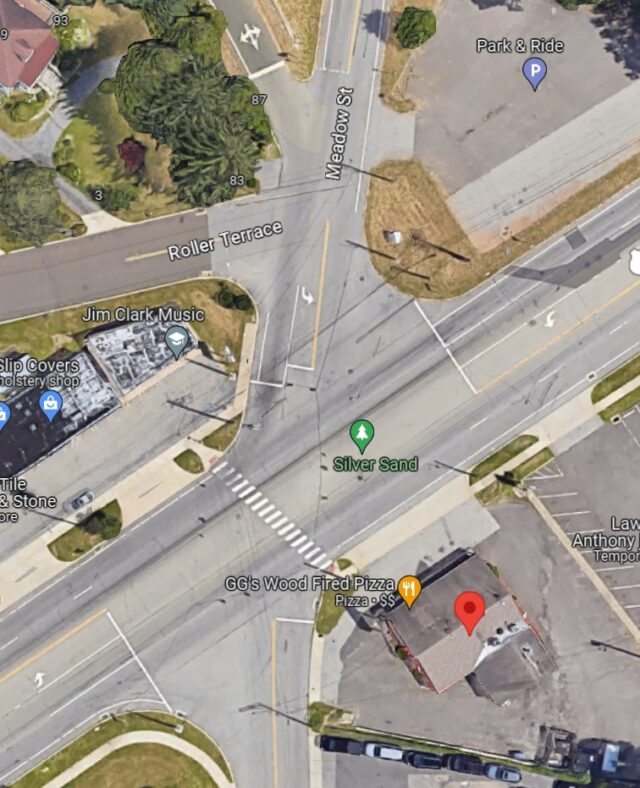
Only one leg of this intersection of Route 1 and Meadow Street has a marked crosswalk. This is five lanes with no median, and it’s near an I-95 exit ramp. The speed limit is 40 MPH. Not every portion of the street has sidewalk.
What this looks like is a town and a state that does not prioritize the health of its residents.
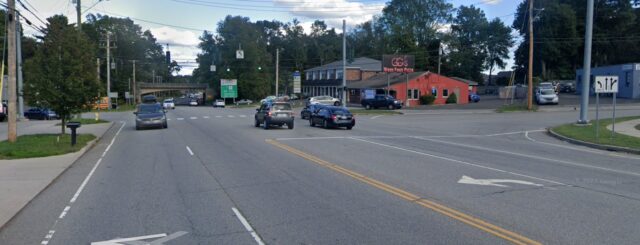
The victim didn’t even stand a chance.
Route 1 is a known problem that Milford and Connecticut should be ashamed of not addressing.
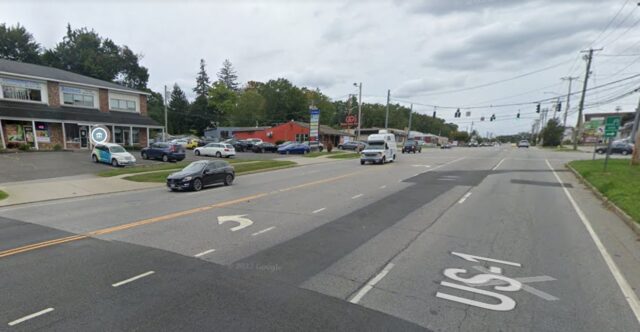
On April 22, 2023, a driver struck and killed Anthony Williams across from several of Hartford’s cultural attractions and around the corner from Hartford Public High School. This is a densely populated area, with many small businesses nearby. This is also on a roadway that received a half-assed “Complete Streets” treatment a few years ago.
The victim was found on the sidewalk.
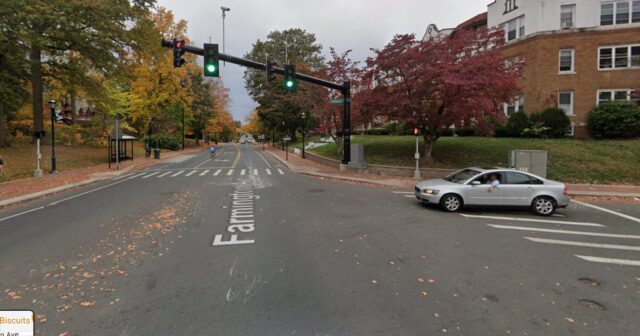
The road is excessively wide for its setting, which means that at 11 PM — the time when the pedestrian was killed — there were even fewer obstacles preventing a motorist from driving fast and reckless. You don’t even need to wait until late in the evening. Observe at any time outside of rush hour, and you will see people choosing to speed far beyond what could be safe to anyone.
The bike lane on Farmington Avenue is unprotected, which means there is no barrier to prevent motorists — anyone from delivery truck drivers or the Hartford Police Department — from blocking them, creating situations like the one you see below. Dangerous to cyclists. Dangerous to drivers crossing the yellow line to pass. Dangerous to those pulling out of the strip mall driveway, who cannot necessarily see beyond the parked vehicle.
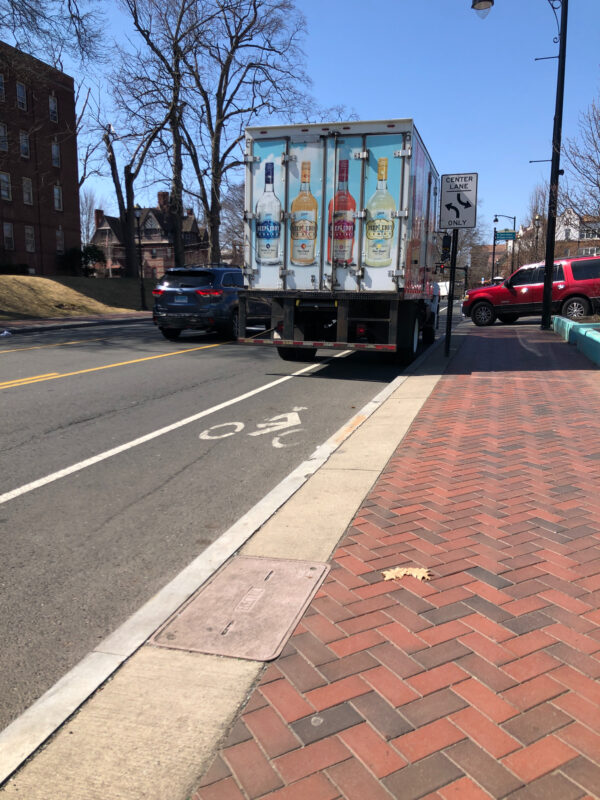
Farmington Avenue is part of my commute. If police are present at all, they’re essentially serving as bouncers for private businesses, observing and dispersing people for loitering or panhandling. It’s rare to see police intervene when someone is behaving recklessly with a vehicle. This is why those who think enforcement is the answer need to get behind automated enforcement and stop begging police to do their jobs better — an effort as meaningless as begging motorists to drive better.
In this case, we can ask our government to finish what they started on Farmington Avenue.
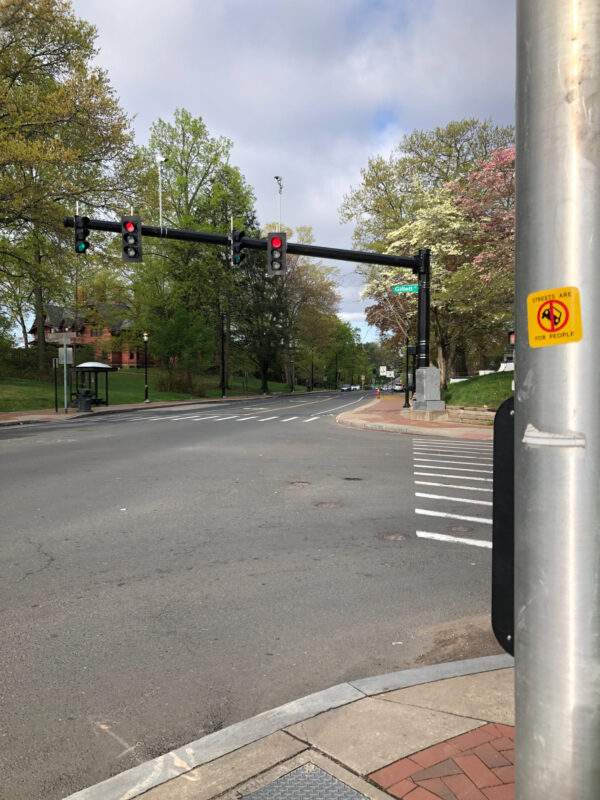
The City of Hartford could have extended medians down Farmington Avenue to downtown, but the first one this motorist would have encountered was right at this intersection. They could have installed wider, barrier-protected bike lanes to offer safety for cyclists directly, and safety for other road users because this feature makes most drivers travel slower — hence, endangering fewer pedestrians and other drivers. Hartford chose not to.
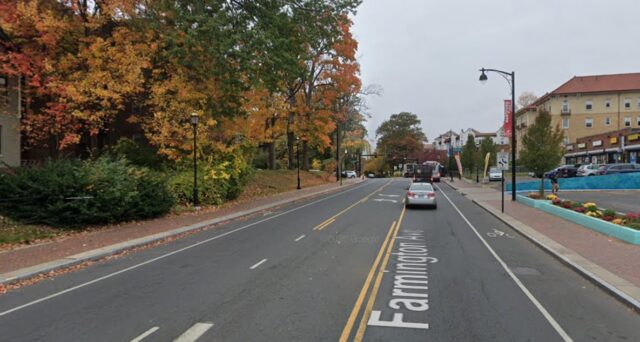
Instead, in the days that followed, I watched as police decided to obstruct the paint-only bike lane in this area.
This is near bus stops on both sides of the road, along with a plaza and many apartment buildings. And it cannot be emphasized enough: this is near the Stowe Center, Twain House, and Hartford Public High School.
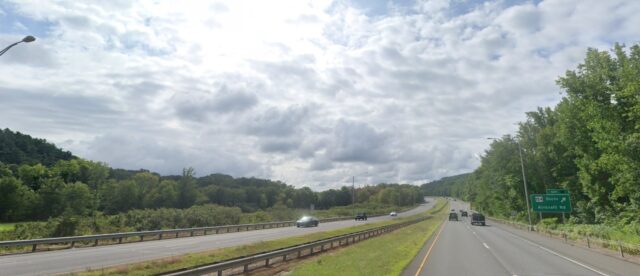
On April 30, 2023, A 29-year old Higganum resident drove her Toyota Corolla into Carlos Morales-Torres Jr. (age 22 of Windham) on southbound Route 9, just before exit 19 (old exit 10). News reports vary in when this happened, with one saying 12:43 AM and others saying 3:40 AM. Ultimately, the CT Crash Data Repository lists time as 3:43 AM.
The victim was reportedly in the right lane when she hit him with her car. No other information has been provided regarding why the victim was using the highway, nor why the driver struck him. In other instances, pedestrians killed on Connecticut’s highways have often been affiliated with a disabled vehicle on a stretch where there was no space to move their vehicle. Like I said, those details were not available for this fatal crash, but if I drove this road regularly, I would start asking questions about where I would be expected to go if I got a flat tire.
And on April 15, 2023, a pedestrian was killed in Naugatuck and there are more questions than answers. From news reports, what information lines up is that Anthony Michael Meier, 24 of Prospect, had been involved in a collision as a driver. He exited the vehicle and left the crash scene. Then, he somehow went from the Route 68 bridge to being on Route 8 below, where multiple motorists struck him with their vehicles. He died from those injuries. Where the details are unclear is what led up to him being on Route 8. Some news reports described him as jumping, others as falling. Some described him as fleeing the scene of a crash, others as fleeing the police — which implies a chase. There is high fencing along most of the Route 68 bridge, though there are places where a person could fairly easily get around.
If you have not already communicated support of HB 5917, the Vision Zero Bill, contact your legislators by May 17, 2023. You can read about the bill here and here. Is there more that can be done beyond what the bill offers? Absolutely. This bill is a huge step in the right direction; it’s not the last or only step.
Safe Streets Connecticut: April 2023
Advocates have been pushing for a change in how crash data is collected. If you spend time in Connecticut’s database, you’ll be both impressed by how much information is provided for every collision, and simultaneously annoyed by what is left out. For instance, after a fatal pedestrian collision, reporters often parrot the police in saying something like “the pedestrian was not in the crosswalk,” but they do not acknowledge that the nearest marked crosswalk was a mile away and inaccessible due to lack of sidewalks. The crash database might reflect reality conditions in the crash diagram — if one is provided — but there is no space, currently, for information about what infrastructure was present for pedestrians. Those reporting with more integrity don’t ding the pedestrian for wrongdoing, but others will say person was using roadway improperly. You can see how this feels like a set up, and how otherwise logical people begin to believe the myth that pedestrians come out of nowhere. It is rare for motorists who are paying attention to encounter a true surprise pedestrian scenario.
Those who are serious about making a dramatic reduction in serious and fatal collisions don’t spend their time defending the broken status quo because of the rare exceptions.
My recent column for CT News Junkie is about how how red herrings (or lies, if we want to be more direct) threaten progress in reducing traffic violence. But it could have also been this, a reminder that there is something morally bankrupt about protecting motorists’ wallets rather than their lives, and the lives of anyone or anything they may snuff out due to fast and reckless driving.
Behind the scenes, some who could have but did not participate in the Vision Zero committee that shaped HB 5917 have relied on hypothetical scenarios while ignoring a well-documented actual equity issue: Black and Hispanic Americans are disproportionately the victims of traffic violence, and this is true whether inside or outside of a vehicle.
We know how to reduce street deaths. It’s no mystery. Changing the infrastructure takes awhile, but is the most effective method. While waiting for cities to add sidewalks, remove car lanes, and install protected bike lanes, automated enforcement should be used, widely.
Last weekend in Connecticut, seven people — this time all drivers or passengers in vehicles — died in crashes. Ever so predictably, the response has been some combination of sending “thoughts and prayers,” telling the public to “hug their loved ones tighter,” and begging/cajoling motorists to drive better.
Here’s the thing:
Asking motorists to drive better is not a strategy. There is no data showing that this method has proven results. It’s what we have leaned heavily on for the last century, yet here we are, every day seeing a steady stream of people killed in preventable collisions. Spend any time on or adjacent to roadways, paying attention, and you will see the driver behavior does not even visibly improve in areas where there was a recent fatal crash.
Think about the advice given to those in parenting roles. Often, you have to make tough or unpopular decisions for the safety of the child. You tell them no, they can’t go to Cindy’s house for a party while her parents are out of town because you know this won’t be a quiet pajama party but the kind of rager where people pass out on the lawn. Junior is pissed, but Junior’s own track record of decisionmaking shows this is the right decision, and Junior won’t be waking up in the hospital getting fluids.
Automated enforcement may hurt people’s bank accounts.
Be mad about it.
It’s not getting pulled over by an officer who might escalate the situation. It’s not a speed trap where police station themselves to be not immediately noticed. (In my hometown, police would position themselves in a residential driveway at the bottom of a steep hill to catch people. Maybe they still do. This road is not where there are serious crashes — that would be the state routes, including where a head-on just killed two drivers recently.) There would be signs announcing the presence of cameras, and they would be used at intersections that have a history of serious crashes.
The opposition is telling on themselves and their own lawless driving, frankly.
With any luck, Connecticut’s decisionmakers have learned from their own peers that people make many poor choices behind the wheel, and that sometimes a bit of inconvenience is what will be best for them — and us all — in the long run.
———————-
In April, drivers killed five pedestrians on Connecticut’s roads.
The driver of an unknown make and model vehicle — this means the motorist did not remain on the scene — hit and killed a 30-year old woman from West Haven in that town on April 29 2023. Although she was described as being in the roadway improperly, you have to understand that she was set up for failure. There is no way for a pedestrian to properly use the road.
Route 162 in West Haven is a classic stroad. To cross it, a person would have to play frogger on five lanes with no median. There are many stores, along with bus stops, that would compel a person to use this area on foot.
There is no marked crosswalk or pedestrian light at the nearest intersection, and even if there were, there is no sidewalk or even much of a shoulder to walk in. The closest one is 0.1 miles away — a two minute walk — but there are no sidewalks on that side of Route 162.
Let’s look at this more carefully, because I don’t expect anyone else to unless a local lawyer decides that a class action suit is the way to go.
The map screenshot below (from October 2022) shows what Route 162 looks like near the intersection the pedestrian would have been expected to use. You can see that there is no sidewalk on one side of the stroad, and that there is not really any place to safely walk. The vegetation is overgrown and there is a fence that would keep people from walking at a safer distance from fast moving vehicles.
Let’s look more closely, still.
If someone managed to walk through the overgrown grass and shrubs — at night when they would not be able to see what was underfoot — they would reach a sidewalk-to-nowhere. These are little pourings of concrete that connect to nothing and are basically engineers saying out loud that they checked a box but don’t actually care about user experience.
You can see what looks like a beg button attached to this light, but there is more overgrown vegetation surrounding it.
Let’s look even closer.
The screenshot below shows the other side of the intersection. There, you can see that the pedestrian would never be summoning their own light phase, but a green light. This is not pedestrian infrastructure. In a state where the gross norm is for motorists to turn right on red without pausing, nevermind to stop for those in the crosswalk, this faux beg button offers nothing.
So, where the currently pedestrian was hit and killed is where most people would attempt to cross — from a stripmall driveway where there is at least some room to stand, across from a bus stop and apartment buildings. This happened at 12:30 AM, and while no information was provided as to where the victim was going, there is bus service in this area late at night. The CT Crash Data Repository describes this area as dark, not lighted.
Let’s look at all of the ways that West Haven and the State of Connecticut have been negligent: no crosswalk, no pedestrian light, no median, no sidewalk, no lighting, 35 MPH speed limit in a populated area. Add to this how the nearest intersection is a three-lane exit ramp that allows drivers to turn right on red. That’s seven bad choices that those in positions of power have repeatedly made, setting up both drivers and pedestrians for failure and danger.
I’ll add one more, actually.
Instead of improving walkability, someone thought that installing a “NO PEDESTRIAN CROSSING” sign (that probably can’t be read from across the street) would be the way to go.
This is the crawliest way for the government, whether town or state, to admit that they are not interested in keeping people safe.
West Hartford recently did their own version of this, but with a “don’t you dare be poor in public” twist.
Asking pedestrians not to use an actual highway makes sense, but the second you start putting apartment buildings and retail plazas down, you need to accommodate those who are going to be living and working in those places — many of whom are taking the bus, biking, or relying on their own feet for transportation.
On April 7, 2023 around 4:09 PM, the driver of a 2015 Kia struck and killed Edward Patrick Austin, 49, of and in Milford.
Here’s what the area looks like:
Only one leg of this intersection of Route 1 and Meadow Street has a marked crosswalk. This is five lanes with no median, and it’s near an I-95 exit ramp. The speed limit is 40 MPH. Not every portion of the street has sidewalk.
What this looks like is a town and a state that does not prioritize the health of its residents.
The victim didn’t even stand a chance.
Route 1 is a known problem that Milford and Connecticut should be ashamed of not addressing.
On April 22, 2023, a driver struck and killed Anthony Williams across from several of Hartford’s cultural attractions and around the corner from Hartford Public High School. This is a densely populated area, with many small businesses nearby. This is also on a roadway that received a half-assed “Complete Streets” treatment a few years ago.
The victim was found on the sidewalk.
The road is excessively wide for its setting, which means that at 11 PM — the time when the pedestrian was killed — there were even fewer obstacles preventing a motorist from driving fast and reckless. You don’t even need to wait until late in the evening. Observe at any time outside of rush hour, and you will see people choosing to speed far beyond what could be safe to anyone.
The bike lane on Farmington Avenue is unprotected, which means there is no barrier to prevent motorists — anyone from delivery truck drivers or the Hartford Police Department — from blocking them, creating situations like the one you see below. Dangerous to cyclists. Dangerous to drivers crossing the yellow line to pass. Dangerous to those pulling out of the strip mall driveway, who cannot necessarily see beyond the parked vehicle.
Farmington Avenue is part of my commute. If police are present at all, they’re essentially serving as bouncers for private businesses, observing and dispersing people for loitering or panhandling. It’s rare to see police intervene when someone is behaving recklessly with a vehicle. This is why those who think enforcement is the answer need to get behind automated enforcement and stop begging police to do their jobs better — an effort as meaningless as begging motorists to drive better.
In this case, we can ask our government to finish what they started on Farmington Avenue.
The City of Hartford could have extended medians down Farmington Avenue to downtown, but the first one this motorist would have encountered was right at this intersection. They could have installed wider, barrier-protected bike lanes to offer safety for cyclists directly, and safety for other road users because this feature makes most drivers travel slower — hence, endangering fewer pedestrians and other drivers. Hartford chose not to.
Instead, in the days that followed, I watched as police decided to obstruct the paint-only bike lane in this area.
This is near bus stops on both sides of the road, along with a plaza and many apartment buildings. And it cannot be emphasized enough: this is near the Stowe Center, Twain House, and Hartford Public High School.
On April 30, 2023, A 29-year old Higganum resident drove her Toyota Corolla into Carlos Morales-Torres Jr. (age 22 of Windham) on southbound Route 9, just before exit 19 (old exit 10). News reports vary in when this happened, with one saying 12:43 AM and others saying 3:40 AM. Ultimately, the CT Crash Data Repository lists time as 3:43 AM.
The victim was reportedly in the right lane when she hit him with her car. No other information has been provided regarding why the victim was using the highway, nor why the driver struck him. In other instances, pedestrians killed on Connecticut’s highways have often been affiliated with a disabled vehicle on a stretch where there was no space to move their vehicle. Like I said, those details were not available for this fatal crash, but if I drove this road regularly, I would start asking questions about where I would be expected to go if I got a flat tire.
And on April 15, 2023, a pedestrian was killed in Naugatuck and there are more questions than answers. From news reports, what information lines up is that Anthony Michael Meier, 24 of Prospect, had been involved in a collision as a driver. He exited the vehicle and left the crash scene. Then, he somehow went from the Route 68 bridge to being on Route 8 below, where multiple motorists struck him with their vehicles. He died from those injuries. Where the details are unclear is what led up to him being on Route 8. Some news reports described him as jumping, others as falling. Some described him as fleeing the scene of a crash, others as fleeing the police — which implies a chase. There is high fencing along most of the Route 68 bridge, though there are places where a person could fairly easily get around.
If you have not already communicated support of HB 5917, the Vision Zero Bill, contact your legislators by May 17, 2023. You can read about the bill here and here. Is there more that can be done beyond what the bill offers? Absolutely. This bill is a huge step in the right direction; it’s not the last or only step.
Related Posts
Place This Place
Hartford Democratic Town Committee Convention: Numbers Game
Incoming Superintendent Describes Entry Plan